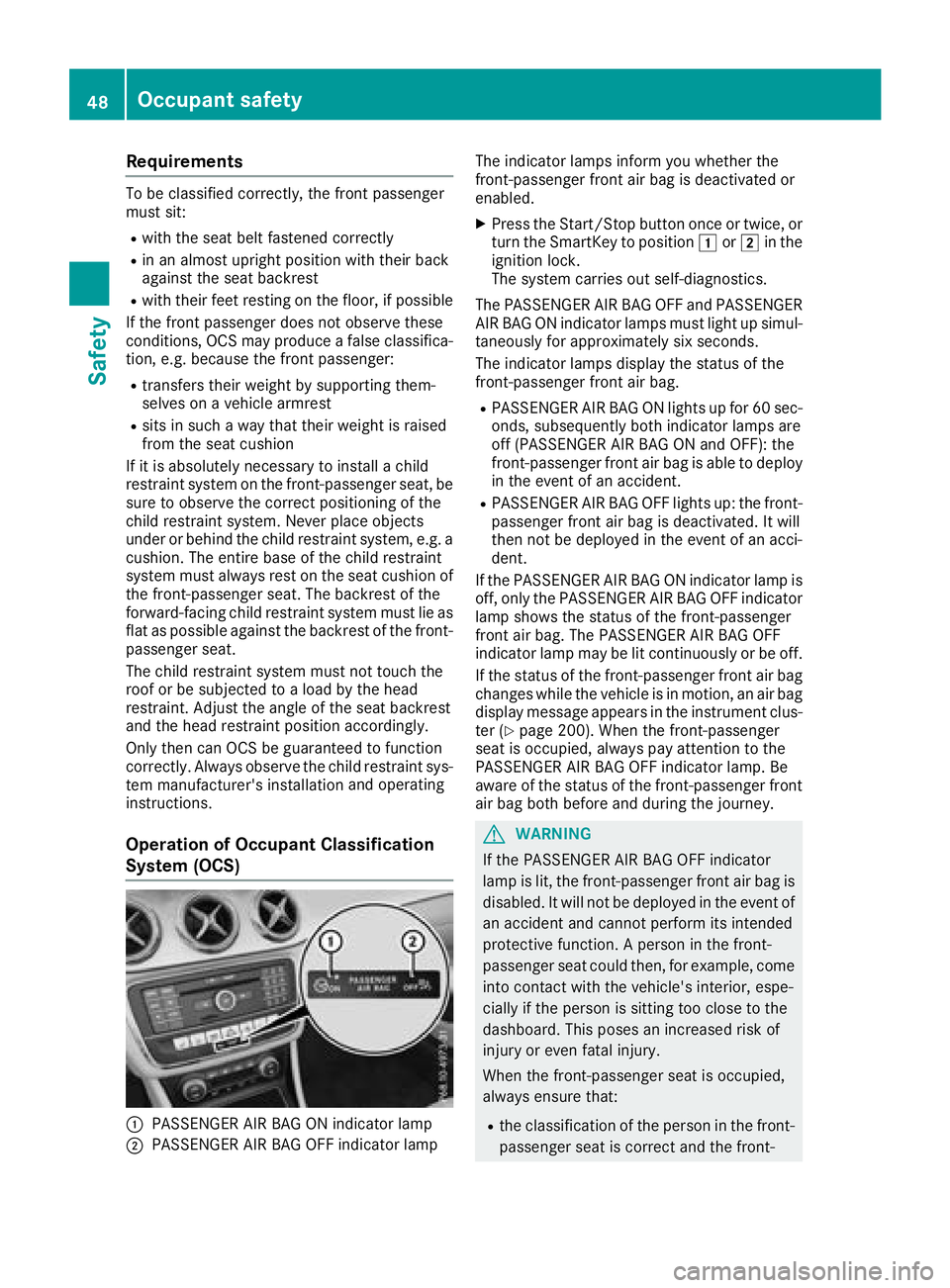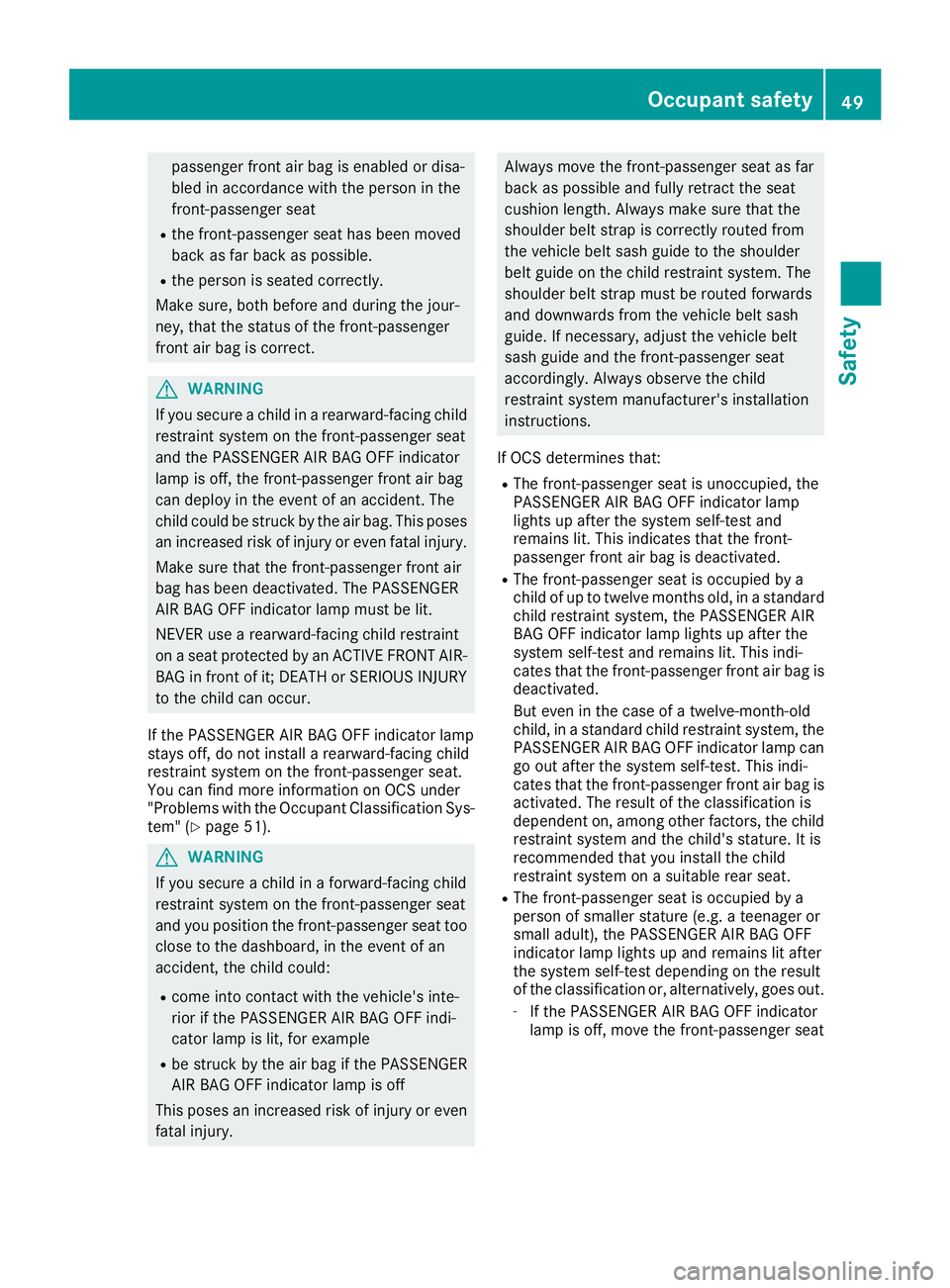2018 MERCEDES-BENZ CLA dashboard warning lights
[x] Cancel search: dashboard warning lightsPage 10 of 326

Storing and maintaining current
speed ............................................. 150
Cup holder
Center console .............................. 243
Important safety notes .................. 242
Rear compartment ......................... 243
Custome rA ssis tance Center
(CAC) ..................................................... 28
Custome rR elations Department ....... 28
DDashboard
see Instrument cluster
Data
see Technica ld at a
Daytime runnin gl amps
Displa ym essage ............................ 204
Function/note s. ............................ 100
Switching on/of f( on -board com-
puter) ............................................. 187
Declarations of conformity ................. 27
Diagnostic sc on nection ...................... 28
Digital Operator's Manual
Hel p. ................................................ 23
Introduction ..................................... 23
Digital speedometer ......................... 181
DIREC TS ELECT lever
Automati ct ransmissio n. ................ 130
Display messages
ASSYST PLU S. ............................... 261
Calling up (on-board computer) ..... 191
Driving systems ............................. 207
Engine ............................................ 205
Genera ln otes ................................ 190
Hiding (on-board computer) ........... 191
Lights ............................................. 202
Safety systems .............................. 192
SmartKey ....................................... 216
Tires ............................................... 211
Vehicl e. .......................................... 213
Distance Pilo tD IS TRONIC
Activating ....................................... 152
Calling up as peed ......................... 153
Cruise control lever ....................... 152
Displa yM essage ............................ 209
Displays in the instrument cluster .. 155
Driving tip s. ................................... 156 Function/note s. ............................ 151
Important safety notes .................. 151
Setting as peed .............................. 154
Setting the specified minimum
distance ......................................... 154
Stopping ........................................ 154
Storing as peed .............................. 153
Switching off .................................. 155
Distance recorder ............................. 180
Distance warnin g( wa rning lamp) .... 227
Distance warnin gf unction
Function/note s. ............................... 62
Warning lamp ................................. 227
Doors
Automati cl oc king (on-board com-
puter) ............................................. 187
Automati cl oc king (switch) ............... 77
Central locking/unlocking
(SmartKey ). ...................................... 70
Control panel ................................... 38
Displa ym essage ............................ 216
Emergency locking ........................... 77
Emergency unlocking ....................... 77
Important safety notes .................... 76
Opening (fro mi nside ). ..................... 76
D ri nking and driving ......................... 144
Drive program
Automati ct ransmission ................. 134
Displa y. .......................................... 132
Displa y( DIRECT SELECT lever) ...... 130
Driver's door
see Doors
Drivin ga broad
Mercedes-Benz Service ................. 262
Drivin gonf loode dr oads .................. 148
Drivin gs afety system
Active Brake Assist .......................... 62
Braking assistance appropriate to
the situation ..................................... 63
Drivin gs afety systems
ABS (Anti-lock Braking System) ....... 61
ADAPTIV EB RAK E. ............................ 68
BAS (Brake Assist System) .............. 61
Distance warning function ............... 62
EBD (electroni cb rake force distri-
bution) ............................................. 678
Index
Page 50 of 326

Requirements To be classifie dc orrectly ,t he front passenger
mus ts it:R
with the sea tb el tf astened correctlyR
in an almost upright position with thei rb ac k
against the sea tb ac krestR
with thei rf ee tr esting on the floor, if possible
If the front passenger doe sn ot observe these
conditions ,O CS may produce af alse classifica-
tion, e.g. because the front passenger: R
transfers thei rw eigh tb ys uppo rting them-
selves on av ehicl ea rmrestR
sits in such aw ay that thei rw eigh tisr aised
from the sea tc ushion
If it is absolutely necessary to install ac hild
restraint system on the front-passenger seat, be
sure to observe the correct positioning of the
child restraint system. Neve rp la ce objects
under or behind the child restraint system, e.g. a
cushion. The entir eb as eoft he child restraint
system mus ta lway sr es tont he sea tc ushio no f
the front-passenger seat. The backrest of the
forward-facing child restraint system mus tl ie as
fla ta sp ossible against the backrest of the front-
passenger seat.
The child restraint system mus tn ot touch the
roo forbes ub jecte dtoal oa dbyt he head
restraint. Adjust the angle of the sea tb ac krest
and the hea dr estraint position accordingly.
Only then can OC Sbeg ua ranteed to function
correctly .A lway so bserve the child restraint sys-
tem manufacturer' si nstallation and o perating
i
nstructions.
Operatio nofO cc upant Classification
System (OCS)
�C
PASSENGER AIR BAG ON indicator lamp
�D
PASSENGER AIR BAG OFF indicator lamp The indicator lamps inform yo uw he the rt he
front-passenger front ai rb ag is deactivated or
enabled. X
Press the Start/Sto pb ut ton once or twice, or
turn the SmartKey to position �G or �H in the
ignition lock.
The system carrie so ut self-diagnostics.
The PASSENGER AIR BAG OFF and PASSENGER
AIR BAG ON indicator lamps mus tl ig ht up simul-
taneously for approximately six seconds.
The indicator lamps display the statu soft he
front-passenger front ai rb ag .R
PASSENGER AIR BAG ON lights up for 60 sec-
onds ,s ub sequently both indicator lamps are
off (PASSENGER AIR BAG ON and OFF) :t he
front-passenger front ai rb ag is able to deploy
in the event of an accident. R
PASSENGER AIR BAG OFF lights up :t he front-
passenger front ai rb ag is deactivated. It will
then not be deploye dint he event of an acci-
dent.
If the PASSENGER AIR BAG ON indicator lamp is
off, only the PASSENGER AIR BAG OFF indicator
lamp shows the statu soft he front-passenger
front ai rb ag .T he PASSENGER AIR BAG OFF
indicator lamp may be li tc ontinuously or be off.
If the statu soft he front-passenger front ai rb ag
changes whil et he vehicl eisinm otion, an ai rb ag
display message appears in the instrument clus-
ter ( Y
page 200). Whe nt he front-passenger
sea ti so ccupied, always pa ya ttention to the
PASSENGER AIR BAG OFF indica tor l amp. Be
a
ware of the statu soft he front-passenger front
ai rb ag both before and during the journey.
G WARNING
If the PASSENGER AIR BAG OFF indicator
lamp is lit, the front-passenger front ai rb ag is
disabled. It will not be deploye dint he event of
an accident and canno tp erform its intended
protectiv ef unction. Ap erson in the front-
passenger sea tc ould then, for example, come
into contact with the vehicle's interior, espe-
ciall yift he person is sitting too close to the
dashboard. Thi sp oses an increased ris ko f
injury or eve nf ata li njury.
Whe nt he front-passenger sea ti so ccupied,
always ensure that: R
the classification of the person in the front-
passenger sea ti sc orrect and the front-48
Occupan ts afety
Safety
Page 51 of 326

passenger fron ta ir bag is enabled or disa-
bled in accordance with the person in the
front-passenger seat R
the front-passenger seat has been moved
back as far back as possible. R
the person is seated correctly.
Make sure, both before and during the jour-
ney, that the status of the front-passenger
fron ta ir bag is correct.
G WARNING
If you secure ac hild in ar earward-facing child
restraint system on the front-passenger seat
and the PASSENGER AIR BA GO FF indicator
lamp is off, the front-passenger fron ta ir bag
can deploy in the event of an accident. The
child could be struck by the air bag. This poses
an increased risk of injury or even fatal injury.
Make sure that the front-passenger fron ta ir
bag has been deactivated. The PASSENGER
AIR BA GO FF indicator lamp must be lit.
NEVER use ar earward-facing child restraint
on as eat protected by an ACTIVE FRONT AIR-
BA Ginf ron tofi t; DEATH or SERIOUS INJURY
to the child can occur.
If the PASSENGER AIR BA GO FF indicator lamp
stays off, do not install ar earward-facing child
restraint system on the front-passenger seat.
You can find more information on OCS under
"Problems with the Occupant Classification Sys-
tem" ( Y
page 51).
G WARNING
If you secure ac hild in af orward-facin gc hild
restraint system on the front-passenger seat
and you position the front-passenger seat too
close to the dashboard, in the event of an
accident, the child could: R
come int oc ontact with the vehicle's inte-
rior if the PASSENGER AIR BA GO FF indi-
cator lamp is lit, for example R
be struck by the air bag if the PASSENGER
AIR BA GO FF indicator lamp is off
This poses an increased risk of injury or even
fatal injury. Always move the front-passenger seat as far
back as possible and fully retract the seat
cushion length. Always make sure that the
shoulder belt strap is correctly routed from
the vehicle belt sash guide to the shoulder
belt guide on the child restraint system. The
shoulder belt strap must be routed forwards
and downwards from the vehicle belt sash
guide. If necessary, adjust the vehicle belt
sash guide and the front-passenger seat
accordingly. Always observe the child
restraint system manufacturer's installation
instructions.
If OCS determines that: R
The front-passenger seat is unoccupied, the
PASSENGER AIR BA GO FF indicator lamp
lights up after the system self-test and
remains lit. This indicates that the front-
passenger fron ta ir bag is deactivated. R
The front-passenger seat is occupied by a
child of up to twelve months old, in as tandard
child restraint system, the PASSENGER AIR
BA GO FF indicator lamp lights up after the
system self-test and remains lit. This indi-
cates that the front-passenger fron ta ir bag is
deactivated.
But even in the case of at welve-month-old
child, in as tandard child restraint system, the
PASSENGER AIR BA GO FF indicator lamp can
go out after the system self-test. This indi-
cates that the front-passenger fron ta ir bag is
activated. The result of the classification is
dependen to n, among other factors, the child
restraint system and the child's stature. It is
recommended that you install the child
restraint system on as uitable rear seat.R
The front-passenger seat is occupied by a
person of smaller stature (e.g. at eenager or
small adult), the PASSENGER AIR BA GO FF
indicator lamp lights up and remains lit after
the system self-test dependin gont he result
of the classification or, alternatively, goes out. -
If the PASSENGER AIR BA GO FF indicator
lamp is off, move the front-passenger seatOccupant safety 49
Safety Z